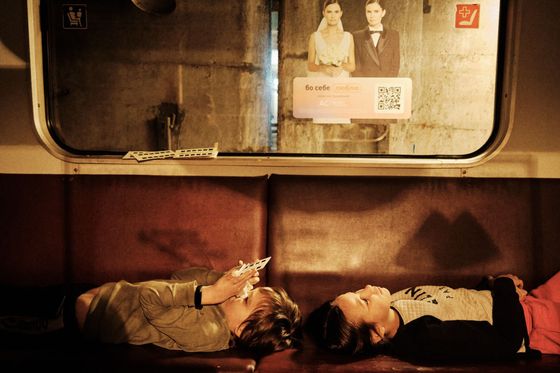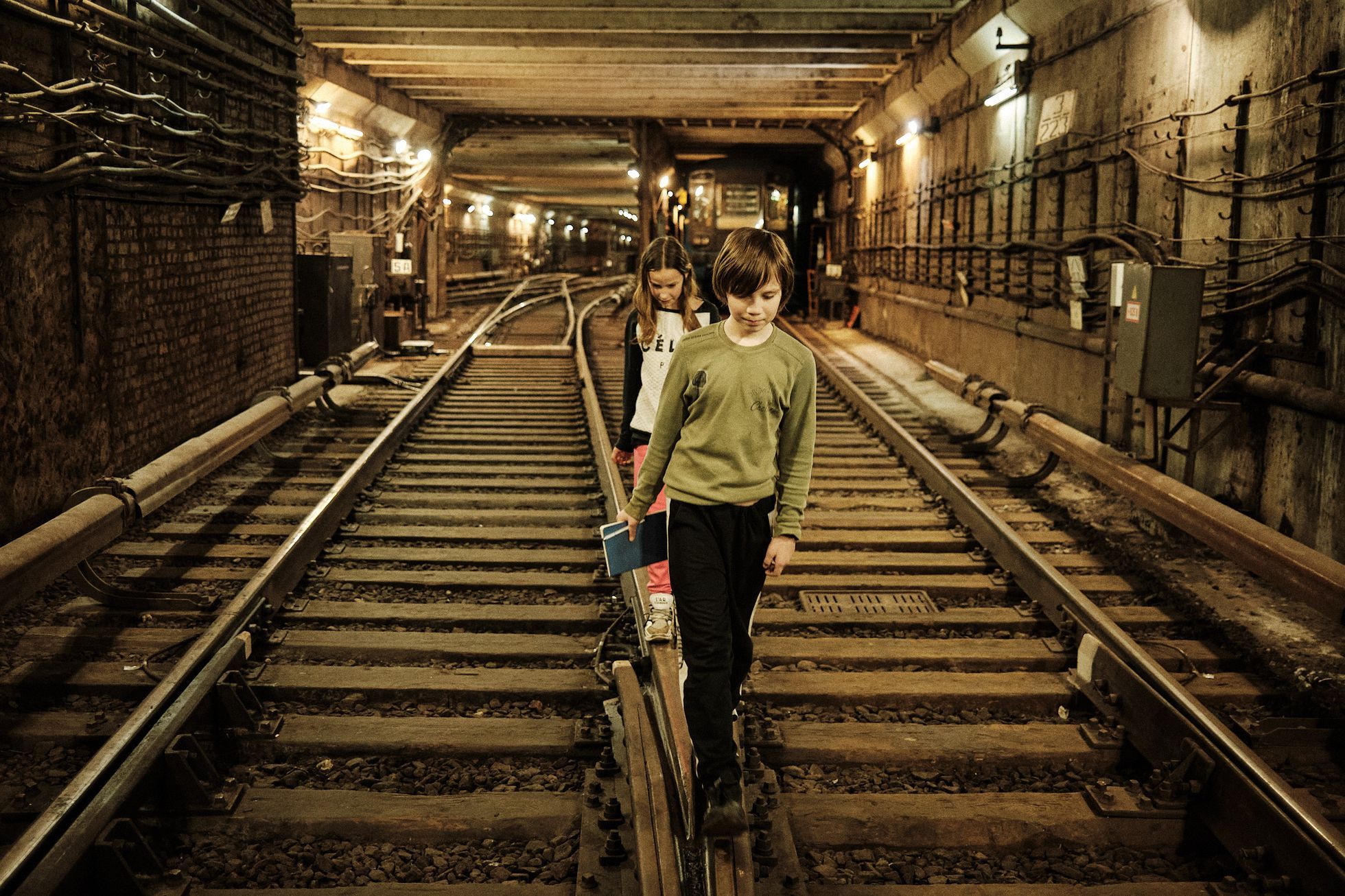A group of workers stand by a damaged structure near the road and try to repair something. When explosions are heard nearby, people leave everything behind and disappear to safety. This is the last time the camera looks above the ground in Lightheadedness. After the opening scene, it disappears into the “underworld” of Kharkiv, Ukraine, where people try to wait out the war.
Twelve-year-old Niki travels through an environment that at first glance resembles a strange market place. With the only difference, in the background there is a currently non-functioning metro set in blue and yellow colors. It became a temporary home for the boy and his family.
Slovak directors Ivan Ostrochovský and Pavol Pekarčík shot a bewitchingly stylized documentary in the bowels of a Kharkiv metro station, which remarkably exceeds the boundaries of simply recording the reality that the inhabitants of war-torn Ukraine had to undergo and still have to undergo.
The heroes of Light-Shyness are played by Viktorija Mac and Nikita Tishchenko. | Photo: CinemArt
Light-Shyness, which won this year’s Jihlava Documentary Film Festival and is already showing in Czech cinemas, is a fragile portrait of a place isolated from the world and daylight. It is the light that poses the danger here. In the seventy-minute film, there are only a few moments when the child heroes are standing near the stairs to the outside, or adults are smoking here. The natural white light that falls on the upper half of the stairs, although people down there lack it, but at the same time it is a taboo that must be avoided.
From precisely constructed static shots, the creators compose an image of a place that seems almost unreal. As if it were a cell of survivors in some kind of post-apocalyptic world, where everything takes place only in the light of neon lights. And where school-aged children learn to live outside the previously known norms of civilization.
When Niki wanders in a subway car or when she and her new friend Vika, a year younger, are balancing on the tracks in the middle of the tunnels, Svetloplachost takes on the lens of the child protagonists, who lack sports, vitamin D, and many, until recently, everyday experiences. At that time, the film resembles an innocent childhood adventure without wanting to belittle the reality up there. On the contrary, he just patiently, non-participatingly, at the same time empathetically observes with the eye of the camera what is happening in that underground microcosm, how people adapt to an unusual new life.

Niki, played by Nikita Tiščenko, travels through an environment that at first glance resembles a strange marketplace. | Photo: CinemArt
This is precisely why the filmmakers managed to film a work that avoids both sentiment and political appeals or indignation at the injustice of the world. All this can be in the background, but Light-Shyness is above all a unique form on the border between documentary and fiction.
The directors Ostrochovský and Pekarčík had previously – for example in Samet’s Terrorists filmed with Peter Kerekes – moved in a similar genre of staged documentary. However, while in this ten-year-old film the trio of normalization men fighting against the regime replayed earlier situations, Svetlophyost is a quiet, calm, observational film.
Only through careful selection of situations, editing and dramaturgical choices does he achieve fine narrative lines. It talks about hope, about how two schoolboys are gradually getting closer and looking for something positive in a world that is collapsing somewhere beyond their reach.
The authors perceive the adult protagonists with a similar feeling. For example, there is a white-bearded, charismatic man in a hat who likes to sing wistful songs and beckons one lady to his humble abode. The creators follow the nascent community, they perceive practical problems affecting mainly children through the eyes of doctors, they do not hide the fact that people are dying at the top. It’s a rather tricky move on the edge, where too much poeticizing of local belonging could lead to overly pathetic conclusions.
Fortunately, Light-Shyness avoids such pitfalls. Small spurts of imagination rather nonviolently capture a child’s perspective, reflect how to cope with traumatic memories.
For example, the girl Vika likes to look through a simple peephole at slides depicting various events from her previous life. When the camera offers us what it sees in them, the grainy photographs turn into short moving fragments of the past on the screen. In a similar way, the actual fragments of memories may work in the heads of many people hiding from the war.
Light-shyness is an apt name. It reflects the strange, timid atmosphere of the microcosm down under bombed Kharkiv, where people are naturally in solidarity with each other without reeking of kitsch. The line is thin, but it is the way the filmmakers deal with a child’s vision of the world that redeems the work from the various traps that are offered.
It could be argued that it is too simple a docudrama that only benefits from the atmosphere of the place and avoids the more problematic aspects of the conflict up there. Or that the story about the rapprochement of a twelve-year-old boy with an eleven-year-old girl would be a great subject for a children’s film – but Svetloplachost is clearly not intended for a compulsory school audience.
However, it is the combination of visually strong footage and a non-flamboyant, deliberately simple tone that allows us to see the Russian invasion of Ukraine without the need to take geopolitical context into account. It is a universal, timeless, poetic drama about people in a liminal situation, capable of reaching an international audience. That’s not enough at all.

Viktorija Mac and Nikita Tishchenko become closer and look for something positive in a world that is collapsing beyond their reach. | Photo: CinemArt
Just like Ivan Ostrochovský’s previous live-action film Servants, Svetlochost combines strongly aestheticized scenes with the desire to capture the atmosphere of difficult times.
In Služebnicy, the sometimes precise black-and-white tuning prevailed over a story from a priestly seminary in the middle of totalitarian Czechoslovakia, which concerned complicated moral choices. A similar objection is offered here. In the new documentary, the images are more restrained, the theme more abstract, while in a certain sense it is a supplement to Ostrochovsky’s previous work.
The servants told of people who seek God, but constantly have to avert their eyes rather than look up “to the heavens” – not even out of piety and humility, but rather out of fear and helplessness.
Light-shyness is a film about people who cannot look up to the light, because above them there is only a concrete ceiling with neon fluorescent lights. In both cases, Ostrochovský manages to find hints and small, sometimes even lyrical gestures where sweeping clichés would be offered.
Film
Light-shyness
Directed by: Ivan Ostrochovský and Pavol Pekarčík
CinemArt, Czech premiere on November 23.


